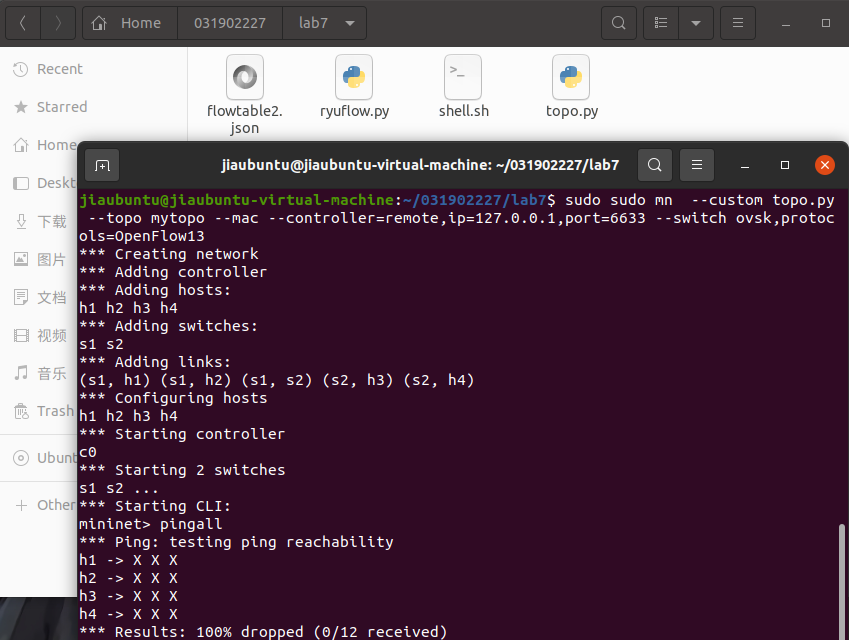一、实验目的
- 能够编写程序调用OpenDaylight REST API实现特定网络功能;
- 能够编写程序调用Ryu REST API实现特定网络功能。
二、实验环境
- 下载虚拟机软件Oracle VisualBox或VMware;
- 在虚拟机中安装Ubuntu 20.04 Desktop amd64,并完整安装Mininet、OpenDaylight(Carbon版本)、Postman和Ryu;
三、实验要求
(一)基本要求
- OpenDaylight
(1) 利用Mininet平台搭建下图所示网络拓扑,并连接OpenDaylight;

(2) 编写Python程序,调用OpenDaylight的北向接口下发指令删除s1上的流表数据。
- Delete.py
#!/usr/bin/python
import requests
from requests.auth import HTTPBasicAuth
def http_delete(url):
url= url
headers = {'Content-Type':'application/json'}
resp = requests.delete(url, headers=headers, auth=HTTPBasicAuth('admin', 'admin'))
return resp
if __name__ == "__main__":
url = 'http://127.0.0.1:8181/restconf/config/opendaylight-inventory:nodes/node/openflow:1/'
resp = http_delete(url)
print(resp.content)

(3) 编写Python程序,调用OpenDaylight的北向接口下发硬超时流表,实现拓扑内主机h1和h3网络中断20s。
Interrupt.py
#!/usr/bin/python
import requests
from requests.auth import HTTPBasicAuth
def http_put(url,jstr):
url= url
headers = {'Content-Type':'application/json'}
resp = requests.put(url,jstr,headers=headers,auth=HTTPBasicAuth('admin', 'admin'))
return resp
if __name__ == "__main__":
url = 'http://127.0.0.1:8181/restconf/config/opendaylight-inventory:nodes/node/openflow:1/flow-node-inventory:table/0/flow/1'
with open("flowstable.json") as f:
jstr = f.read()
resp = http_put(url,jstr)
print (resp.content)
flowstable.jsoh
{
"flow": [
{
"id": "1",
"match": {
"in-port": "1",
"ethernet-match": {
"ethernet-type": {
"type": "0x0800"
}
},
"ipv4-destination": "10.0.0.3/32"
},
"instructions": {
"instruction": [
{
"order": "0",
"apply-actions": {
"action": [
{
"order": "0",
"drop-action": {}
}
]
}
}
]
},
"flow-name": "flow1",
"priority": "65535",
"hard-timeout": "20",
"cookie": "2",
"table_id": "0"
}
]
}

(4) 编写Python程序,调用OpenDaylight的北向接口获取s1上活动的流表数。
get.py
#!/usr/bin/python
import requests
from requests.auth import HTTPBasicAuth
if __name__ == "__main__":
url = 'http://127.0.0.1:8181/restconf/operational/opendaylight-inventory:nodes/node/openflow:1/flow-node-inventory:table/0/opendaylight-flow-table-statistics:flow-table-statistics'
headers = {'Content-Type': 'application/json'}
res = requests.get(url,headers=headers, auth=HTTPBasicAuth('admin', 'admin'))
print (res.content)

- Ryu
(1) 编写Python程序,调用Ryu的北向接口,实现上述OpenDaylight实验拓扑上相同的硬超时流表下发。
- ryuflow.py
#!/usr/bin/python
import requests
if __name__ == "__main__":
url = 'http://127.0.0.1:8080/stats/flowentry/add'
with open("./flowtable.json") as f:
jstr = f.read()
headers = {'Content-Type': 'application/json'}
res = requests.post(url, jstr, headers=headers)
print (res.content)
- flowtable2.json
{
"dpid": 1,
"cookie": 1,
"cookie_mask": 1,
"table_id": 0,
"hard_timeout": 20,
"priority": 65535,
"flags": 1,
"match":{
"in_port":1
},
"actions":[
{
"type":"OUTPUT",
"port": 2
}
]
}

(2) 利用Mininet平台搭建下图所示网络拓扑,要求支持OpenFlow 1.3协议,主机名、交换机名以及端口对应正确。拓扑生成后需连接Ryu,且Ryu应能够提供REST API服务

- topo.py
#!/usr/bin/env python
from mininet.topo import Topo
class MyTopo(Topo):
def __init__(self):
# initilaize topology
Topo.__init__(self)
self.addSwitch("s1")
self.addSwitch("s2")
self.addHost("h1")
self.addHost("h2")
self.addHost("h3")
self.addHost("h4")
self.addLink("s1", "h1")
self.addLink("s1", "h2")
self.addLink("s2", "h3")
self.addLink("s2", "h4")
self.addLink("s1", "s2")
topos = {'mytopo': (lambda: MyTopo())}
打开控制器输入以下命令
ryu-manager ryu.app.simple_switch_13 ryu.app.ofctl_rest

(3) 整理一个Shell脚本,参考Ryu REST API的文档,利用curl命令,实现和实验2相同的VLAN。
| VLAN_ID | Hosts |
|---|---|
| 0 | h1 h3 |
| 1 | h2 h4 |
- shell脚本
# 将主机1,2发送来的数据包打上vlan标记
curl -X POST -d '{
"dpid": 1,
"priority": 1,
"match":{
"in_port": 1
},
"actions":[
{
"type": "PUSH_VLAN",
"ethertype": 33024
},
{
"type": "SET_FIELD",
"field": "vlan_vid",
"value": 4096
},
{
"type": "OUTPUT",
"port": 3
}
]
}' http://localhost:8080/stats/flowentry/add
curl -X POST -d '{
"dpid": 1,
"priority": 1,
"match":{
"in_port": 2
},
"actions":[
{
"type": "PUSH_VLAN",
"ethertype": 33024
},
{
"type": "SET_FIELD",
"field": "vlan_vid",
"value": 4097
},
{
"type": "OUTPUT",
"port": 3
}
]
}' http://localhost:8080/stats/flowentry/add
# 将主机3,4发送来的数据包取出vlan标记
curl -X POST -d '{
"dpid": 1,
"priority": 1,
"match":{
"vlan_vid": 0
},
"actions":[
{
"type": "POP_VLAN",
"ethertype": 33024
},
{
"type": "OUTPUT",
"port": 1
}
]
}' http://localhost:8080/stats/flowentry/add
curl -X POST -d '{
"dpid": 1,
"priority": 1,
"match":{
"vlan_vid": 1
},
"actions":[
{
"type": "POP_VLAN",
"ethertype": 33024
},
{
"type": "OUTPUT",
"port": 2
}
]
}' http://localhost:8080/stats/flowentry/add
# 将主机3,4发送来的数据包打上vlan标记
curl -X POST -d '{
"dpid": 2,
"priority": 1,
"match":{
"in_port": 1
},
"actions":[
{
"type": "PUSH_VLAN",
"ethertype": 33024
},
{
"type": "SET_FIELD",
"field": "vlan_vid",
"value": 4096
},
{
"type": "OUTPUT",
"port": 3
}
]
}' http://localhost:8080/stats/flowentry/add
curl -X POST -d '{
"dpid": 2,
"priority": 1,
"match":{
"in_port": 2
},
"actions":[
{
"type": "PUSH_VLAN",
"ethertype": 33024
},
{
"type": "SET_FIELD",
"field": "vlan_vid",
"value": 4097
},
{
"type": "OUTPUT",
"port": 3
}
]
}' http://localhost:8080/stats/flowentry/add
curl -X POST -d '{
"dpid": 2,
"priority": 1,
"match":{
"vlan_vid": 0
},
"actions":[
{
"type": "POP_VLAN",
"ethertype": 33024
},
{
"type": "OUTPUT",
"port": 1
}
]
}' http://localhost:8080/stats/flowentry/add
curl -X POST -d '{
"dpid": 2,
"priority": 1,
"match":{
"vlan_vid": 1
},
"actions":[
{
"type": "POP_VLAN",
"ethertype": 33024
},
{
"type": "OUTPUT",
"port": 2
}
]
}' http://localhost:8080/stats/flowentry/add

运行shell文件之后

四、实验总结
- 实验难度:较难
- 遇到的问题以及解决办法:在做odl的时候,由于以前一直没有更改默认的python版本号,以前使用的python命令是python3,但是这次做的时候忘记了,导致一直使用python,打开python文件,结果一直错误,但是之后改用了python3 的打开方式之后,解决问题。还有就是在ryu控制器的时候,打开控制器后创建了拓扑但是无法ping通,之后我删除了mininet的缓存,重新启动虚拟机,再打开ryu控制器,结果一切顺利
- 个人感受,自己以前做过的实验,做完之后并没有及时去复习,导致再次做实验的时候,有些命令已经忘记了,还要继续去翻找以前的文件,对于虚拟机的知识了解不够,还需要多加学习。


